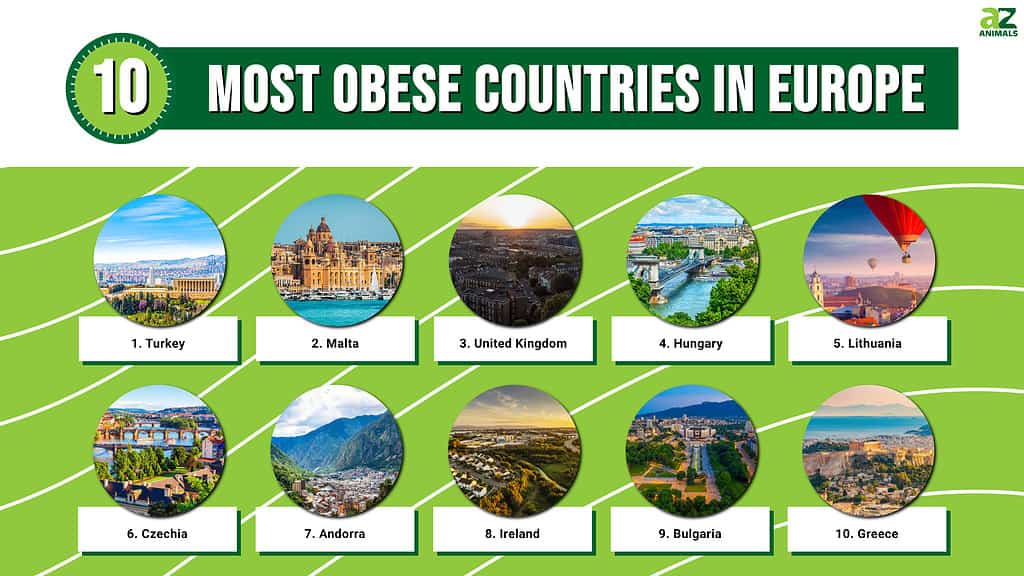According to the World Health Organization (WHO), global obesity has almost tripled between the years 1975 and 2016. In 2016, over 1.9 billion adults (aged 18 years and older) were overweight; of these, more than 650 million were obese. This means that in 2016, 39% of the world’s adult population was overweight (39% of men and 40% of women), and 13% were obese (11% of men and 15% of women). In 2016, more than 340 million children and adolescents (aged 5-19 years) were overweight or obese. Here, we will be focusing on the top 10 most obese countries in Europe, according to the most recent data available from the WHO as of March 26, 2020: 2016 Global Obesity Levels.

How to Measure Obesity
The body mass index (BMI) scale is generally used to measure obesity. BMI checks for weight classifications that may give rise to certain health conditions. A high BMI usually corresponds with high levels of adiposity. The BMI can be used for adults 20 years of age and older. The BMI is calculated by dividing a person’s weight in pounds by the square of their height in inches and multiplying that by a conversion factor of 703.
A BMI between 25.0 and 29.9 falls within the overweight weight category. A BMI of 30.0 or higher falls within the obesity weight category. There are different classifications of obesity, namely class 1 with a BMI between 30 and 34.9, class 2 with a BMI between 35 and 39.9, and class 3 with a BMI of 40 and higher. A BMI between 18.5 and 24.9 is classified as a normal weight category. The same BMI formula used for adults can be used to calculate the BMI for children and teens, but the results are interpreted differently.
1. Turkey
Location
Turkey, also called Türkiye, is a country that geographically lies partly in Europe and partly in Asia. Ankara is the capital city of Turkey.
Global Obesity Rank
Turkey is the most obese country in Europe. 32.1% of the adult population is obese, which places Turkey at a global obesity rank of number 17, according to the WHO. The Organization for Economic Co-operation and Development (OECD), an intergovernmental economic organization that includes 36 wealthy member countries, has placed Turkey in second place out of the top 10 most obese OECD countries.
Causes of Obesity Levels
The contributing factors to the high levels of adult obesity in Turkey include the rise in sedentary lifestyles, poor dietary habits, societal changes, stress (stress-induced eating), depression (emotional eating), and technological developments.

Istanbul is Turkey’s largest city, with over 15 million people.
©Bilal Kocabas/Shutterstock.com
2. Malta
Location
Malta is an island country located in the center of the Mediterranean Sea in Europe. Malta’s capital city is Valetta.
Global Obesity Rank
The WHO has recognized Malta as the European country with the second-highest obesity rate. 28.9% of the adult population is obese, which places Malta at a global obesity rank of number 28.
Causes of Obesity Levels
Most of Malta’s obesity issues are due to an unbalanced diet and low activity levels. They do not eat a Mediterranean diet, as their location implies. A Mediterranean-style diet refers to the traditional dietary habits of countries bordering the Mediterranean Sea. This diet is rich in fruits, vegetables, whole grains, legumes, nuts and seeds, avocado, olives, olive oil, and fish and is low in processed foods, added salt and sugars, refined grains and oils, and alcohol. Maltese people have shifted their dietary habits towards a Western-style diet. This type of diet is ultra-processed and high in unhealthy fats, added sugar, refined grains, alcohol, and salt. It is low in fruits, vegetables, whole grains, and heart-healthy fats. The Maltese people’s diet includes a high consumption of cereals, pasta, bread, dairy products, eggs, red meat, processed meat, salt, and sugar, especially in the form of sugary sodas.
The people of Malta mostly follow a sedentary lifestyle. This is partly attributable to the way the island has been laid out. The Maltese streets, with their narrow sidewalks and fast-moving cars, are unpleasant for pedestrians to walk on. There are plenty of streets on the island, and there are plans to build even more. Most Maltese people own cars, and very few opt to walk or cycle to where they need to go.

The area of Malta is about 122 square miles.
©In Green/Shutterstock.com
3. United Kingdom
Location
The United Kingdom is an island state based off the northwestern coast of mainland Europe. The United Kingdom consists of England, Northern Ireland, Scotland, and Wales. London is the capital city of the United Kingdom.
Global Obesity Rank
According to the WHO, the United Kingdom has a global obesity rank of 33. The United Kingdom is the third-most obese country in Europe, with 27.8% of the adult population being obese. The OECD has placed the United Kingdom in eighth place out of the top 10 most obese OECD countries.
Causes of Obesity Levels
There are various factors that have been contributing to the high levels of obesity in adults in the United Kingdom. The portion sizes have been getting bigger, leading to an increase in the food consumed. The quality of food has decreased, and there has been an increase in the consumption of unhealthy fats and added sugars. Accessing fast food and takeout has become easier as their availability has increased. There has been a higher intake of sugary drinks. And there has been a lower intake of fruits and vegetables.
There has also been an increase in sedentary jobs and lower physical activity levels. Influential and tempting food advertising and marketing have increased. Additionally, there has been an increase in mindless eating habits. And people tend to eat while multi-tasking or working and tend to graze on snacks throughout the day.

Tea is the United Kingdom’s most favored drink.
©iStock.com/Fabio Fusco
4. Hungary
Location
Hungary is a landlocked or noncoastal country based in central Europe. Budapest is the capital city of Hungary.
Global Obesity Rank
Hungary is the fourth-most obese country in Europe and has a global obesity rank of 41, according to the WHO. 26.4% of the adult population is obese. The OECD has placed Hungary in ninth place out of the top 10 most obese OECD countries.
Causes of Obesity Levels
There are various reasons for the high levels of obesity in adults in Hungary. There has been an increase in unhealthy lifestyles. People are consuming more alcohol, have low physical activity levels, and have poor nutritional habits, including a low fruit and vegetable intake.

Hungary is popular for its hot springs and thermal spas.
©Yasonya/Shutterstock.com
5. Lithuania
Location
Lithuania is a country in the Baltic region of Europe, specifically northeastern Europe. Vilnius is the capital city of Lithuania.
Global Obesity Rank
According to the WHO, Lithuania has a global obesity rank of 43. 26.3% of the Lithuanian adult population is obese. Lithuania is the fifth-most obese country in Europe.
Causes of Obesity Levels
Several factors contribute to the high prevalence of adult obesity in Lithuania. There has been an increase in sedentary lifestyles and a decrease in physical activity levels. A higher intake of total energy and fat can be seen. There has also been an increase in alcohol consumption.

Lithuania is a country full of history and culture.
©proslgn/Shutterstock.com
6. Czechia
Location
Czechia, or the Czech Republic, is a landlocked or noncoastal country based in central Europe. Austria, Germany, Poland, and Slovakia border Czechia. Prague is the capital city of the Czech Republic.
Global Obesity Rank
Czechia is the sixth-most obese country in Europe. 26% of the adult population is obese, which places Czechia at a global obesity rank of 46, according to the WHO.
Causes of Obesity Levels
The most predominant reason for the high rate of obesity levels in Czechia is the lack of exercise and sedentary lifestyles among the adult population. There is also a correlation between low education and a higher BMI. Poor diet, including a low intake of fruits and vegetables, smoking, and alcohol consumption, also play a role in the obesity levels of the adult population of Czechia.

Czechia has the largest ancient castle in the world, called Prague Castle.
©Oleksiy Mark/Shutterstock.com
7. Andorra
Location
Andorra is a small landlocked or noncoastal independent European co-principality (or princedom) positioned between France and Spain in the Pyrenees mountains. Andorra la Vella is the capital city of Andorra.
Global Obesity Rank
25.6% of Andorra’s adult population is obese. According to the WHO, Andorra has a global obesity rank of 49. Andorra is the seventh-most obese country in Europe.
Causes of Obesity Levels
There is not much information on the contributing factors to the obesity levels of the adult population in Andorra. However, an increase has been seen in the obesity levels of people who receive a low to middle income and people who are living in an urban setting. Obesity is on the rise as more people of Andorra are consuming fast food; however, most of the population still maintains a Mediterranean-style diet. However, the traditional Andorran diet consists of wholesome, hearty, home-cooked meals. These meals tend to be high in fat and energy, which may also contribute to the adult obesity levels in Andorra.

Andorra is one of the smallest countries in Europe.
©Armando Oliveira/Shutterstock.com
8. Ireland
Location
Ireland is an island in the North Atlantic Ocean off the coast of England and Wales and situated in western Europe. It is the second-largest island in Europe after Great Britain. Ireland’s capital city is Dublin.
Global Obesity Rank
According to the WHO, Ireland has a global obesity rank of 51. Ireland is the eighth-most obese country in Europe, with 25.3% of the adult population being obese.
Causes of Obesity Levels
Numerous elements are playing a role in the adult obesity levels in Ireland. There has been an increase in portion sizes, and people are consuming more food. The marketing and advertising of unhealthy food options are prominent and tempting. Food and its facilities have become more accessible and available. There has also been an increase in the use of technology and cars. And because of this, there has been an increase in sedentary lifestyles. People are moving less during the day and do not partake in enough physical exercise and sports activities.

Ireland is also known as the Emerald Isle.
©mark gusev/Shutterstock.com
9. Bulgaria
Location
Bulgaria, or the Republic of Bulgaria, is a country based in the eastern part of the Balkan Peninsula in southeastern Europe. Sophia is the capital city of Bulgaria.
Global Obesity Rank
Bulgaria is the ninth-most obese country in Europe. 25% of the adult population is obese, which places Bulgaria at a global obesity rank of 53, according to the WHO.
Causes of Obesity Levels
Bulgaria’s obesity levels are mostly attributed to its economic situation and unhealthy lifestyle. They tend to consume a diet high in calories, fats, sugar, salt, and bread. They also have low levels of physical activity and high levels of stress and depression. There has been an increase in emotional eating habits as well. Alcohol consumption has increased. And the choice of cheaper fast foods has also contributed to Bulgaria’s obesity levels. Bulgarians do not prioritize their health. They have stopped having their homemade traditional meals and would rather opt for quick, factory-made meal options to save time.

Bulgaria is one of the oldest countries in Europe.
©trabantos/Shutterstock.com
10. Greece
Location
Greece is a country in southeastern Europe and is based in the southernmost part of the Balkan Peninsula. Athens is the capital city of Greece.
Global Obesity Rank
24.9% of Greece’s adult population is obese. According to the WHO, Greece has a global obesity rank of 54, just after Bulgaria. Greece is the tenth-most obese country in Europe.
Causes of Obesity Levels
Greece’s adult obesity levels are due to several reasons. There has been a decrease in the intake of fruits and vegetables. An increase can be seen in sedentary lifestyles. More time is being spent in front of screens, such as those on computers and televisions. Physical activity levels have decreased, and there is not enough participation in exercise or sports activities. Also, adults are sleeping less. Poor sleeping habits have a negative impact on weight. There has been a higher consumption of energy-dense and high-fat foods, especially sweets, sugary drinks, and unhealthy snacks. Food marketing is directed at quick, fast foods. There has been an increase in the consumption of meat and processed foods. And junk food is cheaper than buying fresh food.

Of the more than 2,000 islands Greece is made up of, only 170 are populated.
©sborisov/iStock via Getty Images
Final Thoughts
Obesity and weight problems are increasing at a rapid rate and form part of the underlying causes of death and disability in the European region. Some European countries have been slowly adopting a Western-type lifestyle, exchanging their active traditional Mediterranean lifestyle for a sedentary modern lifestyle and foods that are processed and high in energy, fat, sugar, and salt. Other factors also contribute to obesity and weight problems, other than the overconsumption of excess calories and low levels of physical activity. These factors include genetics, sleep routines, medications, illnesses, environmental and social influences, and healthcare resources.
Obesity is a serious health concern as it not only increases the risk for chronic diseases such as cardiovascular disease, certain cancers, coronary heart disease, hypertension, and type-2 diabetes but can also give rise to a range of psychological problems in some individuals. It also places significant pressure on the country’s healthcare and social resources.
Summary of the Top 10 Most Obese Countries in Europe
| European Rank | Global Rank | Country | Percentage of Adult Population That Is Obese |
|---|---|---|---|
| #1 | #17 | Turkey | 32.1% |
| #2 | #28 | Malta | 28.9% |
| #3 | #33 | United Kingdom | 27.8% |
| #4 | #41 | Hungary | 26.4% |
| #5 | #43 | Lithuania | 26.3% |
| #6 | #46 | Czechia | 26% |
| #7 | #49 | Andorra | 25.6% |
| #8 | #51 | Ireland | 25.3% |
| #9 | #53 | Bulgaria | 25% |
| #10 | #54 | Greece | 24.9% |
The photo featured at the top of this post is © Fuss Sergey/Shutterstock.com
Thank you for reading! Have some feedback for us? Contact the AZ Animals editorial team.







